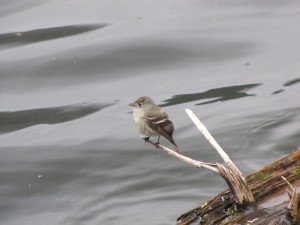The “Two-part Calls” of Empidonax

Empidonax flycatchers are tough to identify by sight. Every birder knows it. They’re the classic bugaboo of North American bird identification. That’s why every field guide mentions the importance of listening to their voices.
But Empids make a lot of sounds. Forget about learning “the song” and “the call.” Most Empids have repertoires of 6-8 different songs and calls. Some species, such as Pacific-slope and Cordilleran, have a dawn song that’s different from anything they say during the day. Several, including Least, Yellow-bellied, Hammond’s, and Dusky, have complex, rarely-heard flight songs. The species with the largest vocabulary appears to be Acadian Flycatcher, which has all of the above types of song plus another type, sometimes called the “evening song,” which is the most complex of all. (It may or may not be fully separate from the flight song.)
Today I’m going to be talking about a class of Empid vocalizations that don’t get much press. I’ll call them “Two-part Calls” since they don’t have an official name. Based on their similarity, the “two-part calls” appear to be homologous — that is, evolutionarily equivalent, all descended from the same calling behavior of a common ancestor.
As far as I know, three species of Empids give these calls. In one species, the two-part call is familiar enough to be mentioned in field guides, at least. The two-part call of the second species is described only in the scientific literature. And that of the third is, as far as I know, being described in this blog post for the first time.
Dusky Flycatcher: “Du-hic”
This call is mentioned in the Sibley Guide to Birds, Kenn Kaufmann’s Advanced Birding, and other well-researched field guides. The “du” part of the call is nearly monotone, and the “hic” is shorter and slightly higher. As you can hear in the following examples, the sequence is often more like “du, du, du, du, du-hic”. Sometimes the “hic” notes will be given without a “du,” or after other “hics.”
This call may be given primarily by males, but I’m not certain of that. It’s given throughout the breeding season, but especially in long bouts at dawn and dusk during the early summer, prior to egg laying.
Hammond’s Flycatcher: “Peer-pewit”
Quite similar to Dusky’s “du-hic” but not mentioned in any field guides that I know, this call was first described in the scientific literature by James Sedgwick in 1975. Sedgwick called it the “k-lear whee-zee” call, but I think “peer-pewit” is a better transliteration. The “peer” note is slightly more downslurred than Dusky’s “du,” and the “pewit” is higher, longer, and much more distinctly two-syllabled than Dusky’s “hic.” It’s given in similar situations to the “du-hic,” though it’s apparently more likely to be heard later in the breeding season, after egg laying.
Yellow-bellied Flycatcher: “Whit-beert”
I stumbled across this vocalization in a good recording by Randy Little from Herkimer County, New York, which appears to be the only such recording in existence. The call is clearly related to the “du-hic” and “peer-pewit” of the western species, but instead of a drawn-out whistle, the first note is an emphatic “whit!” that resembles a more explosive version of the “whit” calls of other Empids. The second note is again an up-down-up trace on the spectrogram, rather like the Hammond’s “pewit” note.

(Click here to listen to the original recording on the Macaulay Library website.)
I cannot find any definite mention of the “whit-beert” call of Yellow-bellied Flycatcher in any published source. The only possible reference I’ve found is this brief statement in the Birds of North America account:
One variation of Tu-Wee Call is of longer duration, described as thoo weep eh, thoo weep eh, or she weeps sir (Hausman 1946), or pea-wayk-pea-wayk (Dr. Hoy in Forbush 1927) and may actually represent call of different function.
That’s it. Not much to go on.
So we’re left with more questions than answers. Do other Empids give “two-part calls”? What functions do they serve in each species? Are they ever given by migrants? Are they very rare in the Yellow-bellied Flycatcher, or merely under-reported?
I’d be interested to hear anybody else’s experience with this type of call in Empids.
2 thoughts on “The “Two-part Calls” of Empidonax”
I hear Hammond’s giving the “peer-pewit” calls regularly throughout the breeding season; at times the “peer” is given singly. I generally hear “pip” calls most often from migrants, but sometimes I’ll hear the “peer” given singly from migrants (I just heard one bird doing this a few days ago). I have not yet heard the full “peer-pewit” series from birds on migration.
I just uploaded a recording of some high-intensity vocalizations given by three Hammond’s that were in close proximity and giving short chases to each other. This was at the beginning of the breeding season in nesting habitat (Douglas-fir forest canopy). Song phrases were mixed with peers, pewits and “pip” calls. Often during chases, and at other times as well, they were giving a series of higher frequency overslurred notes, often between 5-7 khz. I’ve heard this before during copulation and displays as well. Here’s some links to this recording (in 3 parts):
http://www.xeno-canto.org/110172
http://www.xeno-canto.org/110173
http://www.xeno-canto.org/110174
On another note I recorded several Hammond’s fledgling calls this year – very different and very neat. I’ll upload some of these later.
Ian
Nathan, I am seeking permission to use one of your spetrograph images in my PhD thesis.
Robert Burrell
Comments are closed.